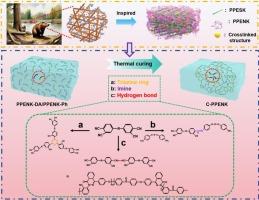Beaver dam-inspired semi-interpenetrating polymer network with local crosslinks: A synergistic approach for high-strength, flame-retardant, and thermally stable thermoplastic composites
IF 6.3
2区 化学
Q1 POLYMER SCIENCE
引用次数: 0
Abstract
To overcome the challenge of simultaneously optimizing multiple properties in thermoplastic resins, we propose a molecular network strategy inspired by the branch-skeleton–clay interlocking architecture of beaver dams. In this bioinspired design, rigid entangled polymer chains form a branch-like skeletal network, while amino- and cyano-based secondary crosslinks act as clay-like fillers. This hierarchical structure mimics the graded energy dissipation mechanism found in natural dams. The optimized polymer exhibits outstanding performance: compressive strength of 200.6 MPa at 25 °C, >85 % modulus retention at 150 °C, and an intrinsic UL-94V-0 flame-retardant rating, with 1 % weight-loss temperatures of 441 °C (N2) and 435 °C (air). This approach yields a new class of resin matrices combining mechanical robustness, intrinsic flame resistance, and thermal stability for extreme applications (e.g., high-temperature aerospace seals and flame-resistant 5G electronics housings).

具有局部交联的海狸坝启发的半互穿聚合物网络:高强度,阻燃和热稳定的热塑性复合材料的协同方法
为了克服同时优化热塑性树脂多种性能的挑战,我们提出了一种受海狸坝树枝-骨架-粘土互锁结构启发的分子网络策略。在这个受生物启发的设计中,刚性纠缠的聚合物链形成了一个分支状的骨架网络,而氨基和氰基的二次交联则充当了粘土状的填料。这种分层结构模拟了天然大坝的梯度能量耗散机制。优化后的聚合物表现出优异的性能:在25°C时抗压强度为200.6 MPa,在150°C时模量保持率为85%,在441°C (N2)和435°C(空气)时失重率为1%,阻燃等级为UL-94V-0。这种方法产生了一种新型树脂基体,结合了机械坚固性、内在阻燃性和热稳定性,适用于极端应用(例如,高温航空航天密封件和阻燃5G电子产品外壳)。
本文章由计算机程序翻译,如有差异,请以英文原文为准。
求助全文
约1分钟内获得全文
求助全文
来源期刊

European Polymer Journal
化学-高分子科学
CiteScore
9.90
自引率
10.00%
发文量
691
审稿时长
23 days
期刊介绍:
European Polymer Journal is dedicated to publishing work on fundamental and applied polymer chemistry and macromolecular materials. The journal covers all aspects of polymer synthesis, including polymerization mechanisms and chemical functional transformations, with a focus on novel polymers and the relationships between molecular structure and polymer properties. In addition, we welcome submissions on bio-based or renewable polymers, stimuli-responsive systems and polymer bio-hybrids. European Polymer Journal also publishes research on the biomedical application of polymers, including drug delivery and regenerative medicine. The main scope is covered but not limited to the following core research areas:
Polymer synthesis and functionalization
• Novel synthetic routes for polymerization, functional modification, controlled/living polymerization and precision polymers.
Stimuli-responsive polymers
• Including shape memory and self-healing polymers.
Supramolecular polymers and self-assembly
• Molecular recognition and higher order polymer structures.
Renewable and sustainable polymers
• Bio-based, biodegradable and anti-microbial polymers and polymeric bio-nanocomposites.
Polymers at interfaces and surfaces
• Chemistry and engineering of surfaces with biological relevance, including patterning, antifouling polymers and polymers for membrane applications.
Biomedical applications and nanomedicine
• Polymers for regenerative medicine, drug delivery molecular release and gene therapy
The scope of European Polymer Journal no longer includes Polymer Physics.
 求助内容:
求助内容: 应助结果提醒方式:
应助结果提醒方式:


